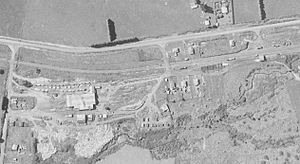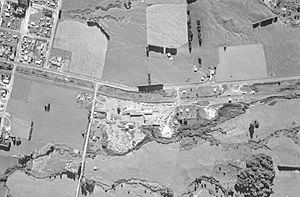Ōwhango railway station facts for kids
Quick facts for kids
Ōwhango railway station
|
|||||||||||
|---|---|---|---|---|---|---|---|---|---|---|---|

Ōwhango railway station about 1910
|
|||||||||||
| Location | New Zealand | ||||||||||
| Coordinates | 39°00′24″S 175°22′35″E / 39.006577°S 175.376367°E | ||||||||||
| Elevation | 457 m (1,499 ft) | ||||||||||
| Line(s) | North Island Main Trunk | ||||||||||
| Distance | Wellington 371.89 km (231.08 mi) | ||||||||||
| History | |||||||||||
| Opened | 1905 | ||||||||||
| Closed | 2 June 1985 | ||||||||||
| Electrified | June 1988 | ||||||||||
| Services | |||||||||||
|
|||||||||||
The Ōwhango railway station was once a busy stop on the North Island Main Trunk line in New Zealand. It served the small village of Ōwhango, located in the Ruapehu District. This station was an important link for the community for many years.
It was located about 5.64 km (3.50 mi) north of Oio and 9.11 km (5.66 mi) south of Kakahi. The area around the railway route was cleared of bush in 1904. By August 1905, Ōwhango became a "railhead," meaning it was the end of the railway line at that time.
Contents
Building the Station
The Public Works Department built the station. They officially handed it over to NZ Railways on 9 November 1908.
Early Features
By March 1908, the station had several important features:
- A passenger platform, 225 ft (69 m) long and 20 ft (6.1 m) wide.
- A shelter shed for passengers, with a lobby and a small store.
- A tablet office, which helped control train movements safely.
- A loading bank for goods.
- Yards and pens for cattle.
- A goods shed, 30 ft (9.1 m) by 20 ft (6.1 m), with a verandah.
- Toilets and four large water tanks. These tanks held 2,000 imp gal (9.1 m3) of water, supplied by a special pump called a hydraulic ram.
Station Upgrades
Ōwhango was considered a "6th class station," a standard design for smaller stations. By November 1908, a path for carts to reach the platform and fixed signals were added. A sheep yard was built in 1909. In 1912, the platform was made even bigger.
In 1964, the wooden front of the platform was replaced. Sadly, on 30 January 1965, the main station building burned down. A new building, with a brick veneer and a concrete floor, was built by July 1980.
Train Operations
The station had a passing loop, which is an extra track allowing trains to pass each other. In 1908, this loop could hold 48 wagons. By 1980, it was extended to hold 82 wagons.
Timber Industry
In 1910, a large timber mill and a special siding (a short track) were built at Ōwhango. This was important for the local economy. In 1911, the station handled about six wagon loads of timber every day. This timber came from five nearby sawmills, which cut trees like matai, rimu, and kahikatea.
The End of the Line
Passenger trains stopped coming to Ōwhango by 1976. The station officially closed for goods transport on 2 June 1985. Even though the station is no longer active, the crossing loop (the passing track) is still used by trains today.



